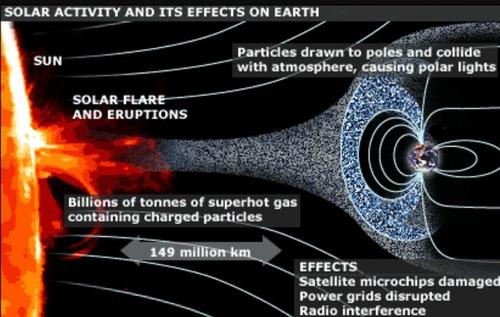"The solar flare is eruptive and seems likely to produce a CME in Earth's direction."
By Tyler Durden: The space weather community on social media platform X reports a powerful solar flare around the center disk of the sun that almost registered as an X-class earlier today.
Space weather and aurora website SolarHam reports,
"A strong solar flare (M9.8) was just detected around AR 3500 near
center disk. A wave of plasma appears to be leaving the flare site, a
good sign for a potential Earth-directed eruption."
"Might as well call it an X-Flare!" one X user said.A strong solar flare (M9.8) was just detected around AR 3500 near center disk. A wave of plasma appears to be leaving the flare site, a good sign for a potential Earth directed eruption. https://t.co/aqK4Q6XdAY pic.twitter.com/BnE76wCUAu
— SolarHam (@SolarHam) November 28, 2023
"The solar flare is eruptive and seems likely to produce a CME in Earth's direction. The radiation caused by the solar flare is also affecting Earth's ionosphere on the daylit side and may interfere with users of high-frequency radio communications," aurora forecast website Space Weather Watch wrote in an X post.Strong Solar Flare - Might as well call it an X-Flare!
— Oppenheimer Ranch Project (@Diamondthedave) November 28, 2023
A noteworthy solar flare reaching very close to the X1.0 threshold was just detected around AR 3500 at 19:50 UTC (Nov 28) The source was AR 3500, now in a good position for Earth directed eruptions. In fact, a wave of plasma… pic.twitter.com/gy43kILXNe
Impressive solar flare occurring now from center disk, currently an M8.5-class solar flare and still rising. The solar flare is eruptive and seems likely to produce a CME in Earth's direction.
— Space Weather Watch (@spacewxwatch) November 28, 2023
The radiation caused by the solar flare is also affecting Earth's ionosphere on the… pic.twitter.com/kv114L8UVc
University of Maryland Solar physicist Keith Strong said, "In about a week (assuming it survives) it will move into a geoeffective position and high-speed solar wind from it will likely impact the Earth, causing geomagnetic storms."
CORONAL HOLE ALERT! A large coronal hole has just appeared over the E limb close to the equator (dark area). In about a week (assuming it survives) it will move into a geoeffective position and high-speed solar wind from it will likely impact the Earth causing geomagnetic storms pic.twitter.com/T15exgwjnC
— Keith Strong (@drkstrong) November 28, 2023
The commonly used system for classifying solar flares categorizes them based on their intensity. The weakest are A-class flares, followed in ascending order of strength by B, C, M, and X classes.
Powerful X-class solar flares can cause damage, particularly to satellites, communications systems, and power grids on Earth.
The frequency of solar flares increases as the sun moves towards another solar maximum.


No comments:
Post a Comment